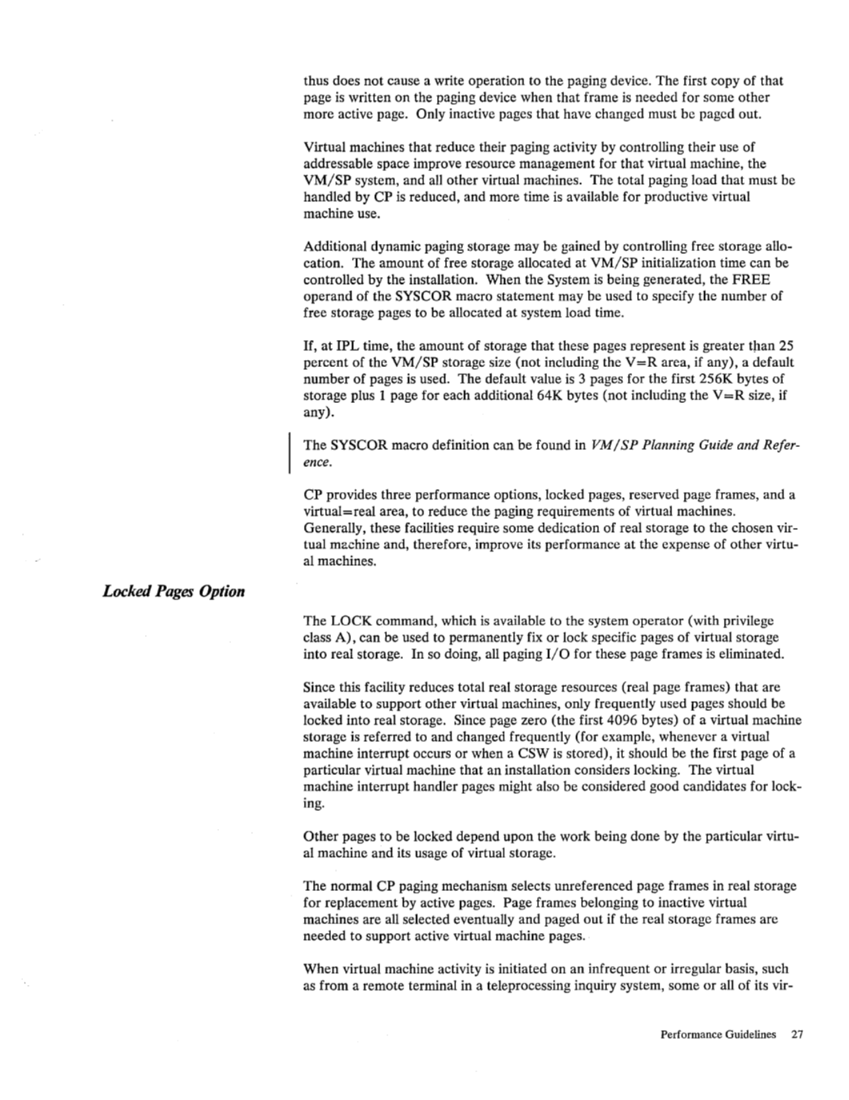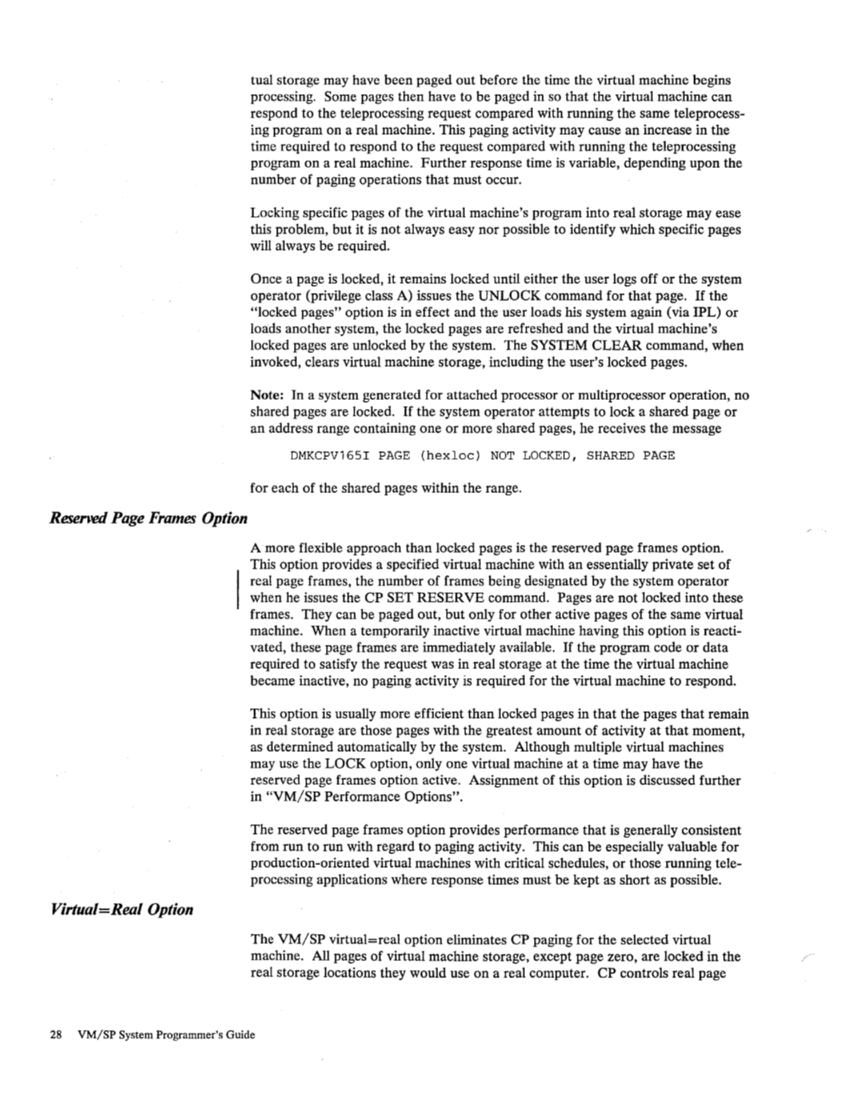Locked Pages Option
thus does not cause a write operation to the paging device. The first copy of that
page is written on the paging device when that frame is needed for some other
more active page.Only inactive pages that have changed must be paged out.
Virtual machines that reduce their paging activity by controlling their use of
addressable space improve resource management for that virtual machine, the
VM/SP system, and all other virtual machines. The total paging load that must be
handled by CP is reduced, and more time is available for productive virtual
machine use.
Additional dynamic paging storage may be gained by controlling free storage allo
cation. The amount of free storage allocated at VM/SP initialization time can be
controlled by the installation. When the System is being generated, the FREE
operand of theSYSCOR macro statement may be used to specify the number of
free storage pages to be allocated at system load time.
If, at IPL time, the amount of storage that these pages represent is greaterthan 25
percent of the VM/SP storage size (not including the V=R area, if any), a default
number of pages is used. The default value is 3 pages for the first 256K bytes of
storage plus 1 page for each additional 64K bytes (not including theV =R size, if
any).
TheSYSCOR macro definition can be found in VM / SP Planning Guide and Refer
ence.
CP provides three performance options, locked pages, reserved page frames, and a
virtual=real area, to reduce the paging requirements of virtual machines.
Generally, these facilities require some dedication of real storage to the chosen vir
tual machine and, therefore, improve its performance at the expense of other virtu
al machines.
TheLOCK command, which is available to the system operator (with privilege
class A), can be used to permanently fix or lock specific pages of virtual storage
into real storage. In so doing, all pagingI/O for these page frames is eliminated.
Since this facility reduces total real storage resources (real page frames) that are
available to support other virtual machines, only frequently used pages should be
locked into real storage. Since page zero (the first4096 bytes) of a virtual machine
storage is referred to and changed frequently (for example, whenever a virtual
machine interrupt occurs or when a CSW is stored), it should be the first page of a
particular virtual machine that an installation considers locking. The virtual
machine interrupt handler pages might also be considered good candidates for lock
ing.Other pages to be locked depend upon the work being done by the particular virtu
al machine and its usage of virtual storage.
The normal CP paging mechanism selects unreferenced page frames in real storage
for replacement by active pages. Page frames belonging to inactive virtual
machines are all selected eventually and paged out if the real storage frames are
needed to support active virtual machine pages.
When virtual machine activity is initiated on an infrequent or irregular basis, such
as from a remote terminal in a teleprocessing inquiry system, some or all of its vir-
Performance Guidelines 27
thus does not cause a write operation to the paging device. The first copy of that
page is written on the paging device when that frame is needed for some other
more active page.
Virtual machines that reduce their paging activity by controlling their use of
addressable space improve resource management for that virtual machine, the
VM/SP system, and all other virtual machines. The total paging load that must be
handled by CP is reduced, and more time is available for productive virtual
machine use.
Additional dynamic paging storage may be gained by controlling free storage allo
cation. The amount of free storage allocated at VM/SP initialization time can be
controlled by the installation. When the System is being generated, the FREE
operand of the
free storage pages to be allocated at system load time.
If, at IPL time, the amount of storage that these pages represent is greater
percent of the VM/SP storage size (not including the V=R area, if any), a default
number of pages is used. The default value is 3 pages for the first 256K bytes of
storage plus 1 page for each additional 64K bytes (not including the
any).
The
ence.
CP provides three performance options, locked pages, reserved page frames, and a
virtual=real area, to reduce the paging requirements of virtual machines.
Generally, these facilities require some dedication of real storage to the chosen vir
tual machine and, therefore, improve its performance at the expense of other virtu
al machines.
The
class A), can be used to permanently fix or lock specific pages of virtual storage
into real storage. In so doing, all paging
Since this facility reduces total real storage resources (real page frames) that are
available to support other virtual machines, only frequently used pages should be
locked into real storage. Since page zero (the first
storage is referred to and changed frequently (for example, whenever a virtual
machine interrupt occurs or when a CSW is stored), it should be the first page of a
particular virtual machine that an installation considers locking. The virtual
machine interrupt handler pages might also be considered good candidates for lock
ing.
al machine and its usage of virtual storage.
The normal CP paging mechanism selects unreferenced page frames in real storage
for replacement by active pages. Page frames belonging to inactive virtual
machines are all selected eventually and paged out if the real storage frames are
needed to support active virtual machine pages.
When virtual machine activity is initiated on an infrequent or irregular basis, such
as from a remote terminal in a teleprocessing inquiry system, some or all of its vir-
Performance Guidelines 27



































































































































































































































































































































































































































































































































































































































